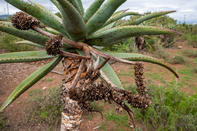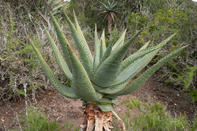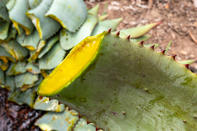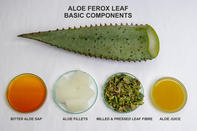Advantageous Properties
At some point, someone stumbled upon the advantageous properties of the aloe ferox plant. Whether this stumble was deliberate or accidental is not documented, but what is documented is the historical use of the plant, by the native inhabitants of the Western Cape.

The first known people to inhabit the Western Cape centuries ago were the San, who were later called bushmen by the European settlers to the Cape. Depicted within their rock art are representations of aloes, three such depictions have been discovered, communicating the important role aloe played in their daily practice.
Xhosa mothers of the past have been known to utilise the bitterness of aloe ferox during the weaning process, by rubbing it on their nipples, in order to get their babies to stop breastfeeding.
Plant Description

Succulents are known for their thick and fleshy leaves, yet not all succulents are the same. For example, aloe ferox is known for its size - it can reach 3 m in height, and at its centre blooms striking flowers that showcase red or orange hues.
This hardy plant is especially suited to areas that are water restricted, which is a favourable characteristic to possess, especially during the dry season.
This single-stemmed aloe has smooth leaves with serrated-like edges, which are prickly to the touch, and assume a rosette-like formation. In its core bloom are a cluster of flowers, that are either red or orange in colour. These flowers generally occur from the months of May up until September.
Internal Composition

The internal composition of aloe ferox is comprised of three basic layers. These layers are as follows:
The aloe rind - the protective, green outer layer or skin (epidermis). The rind is not known to have nutritional worth. This layer contains chloroplasts. Chloroplasts are green plant cells that contain chlorophyll, which is vital for photosynthesis, a process by which the plant uses energy from sunlight to produce its own life-giving energy.
The inner leaf - the fleshy and clear portion of the leaf, which is also known as the mesophyll. This part of the aloe contains plenty of nutrients for both internal and external use. The mesophyll plays a vital role during the photosynthesis process and consists of parenchyma cells, that store the leaf gel containing alkaloids, anthraquinones, anthrones, chromones, flavonoids, coumarins and pyrones.
The aloe latex - the layer that occurs just beneath the rind is yellow and bitter to the taste. It is known to have a strong odour and is not recommended for internal consumption. This layer between the rind and the fleshy middle is made up of vascular bundles, which consists of xylem, phloem and pericyclic tubules.
Basic Components

Waste not want not is an adage that stands proud during the aloe ferox production process. All the basic components of the aloe are used, resulting in plenty of useful products. The outer and inner flesh layers end up as bitter aloe sap, aloe fillets, milled and pressed leaf fibre, and aloe juice. Each component serves a beneficial purpose for a range of ailments such as sunburn, cold sores, psoriasis, fever, itching inflammation and stomach ulcers.
The bitter aloe sap is known for its natural laxative properties and can assist to alleviate the discomfort of constipation.